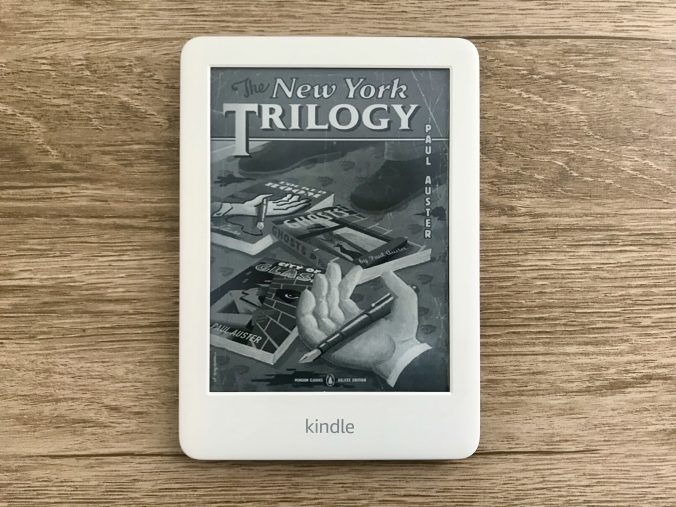[SCROLL DOWN FOR THE ENGLISH VERSION]
A Trilogia de Nova York (Companhia das Letras, 344 páginas) é o tipo de livro que surpreende. À primeira vista, parece um romance policial, mas, à medida que as tramas evoluem, percebemos que as empreitadas detetivescas são apenas a superfície de questionamentos que vão muito além de um mistério policial. São três histórias que se passam na cidade de Nova York e que compartilham muito mais que o cenário agitado de uma grande metrópole e o tom noir.
Na primeira narrativa, Cidade de Vidro, um escritor de romances policiais cheio de problemas em sua vida pessoal acaba se tornando, por acaso, detetive de uma investigação particular. O que era, até então, para ele, apenas objeto de ficção se torna sua realidade. E, para deixar a trama ainda mais intrincada, um dos personagens leva um nome pra lá de familiar: Paul Auster. Você já pode imaginar quantas conexões malucas essa leitura permite!
Fantasmas, a segunda história do livro, segue a linha de detetives, perseguições e mistérios. São quatro personagens, todos eles com nomes de cores, cujos caminhos se cruzam por uma investigação. Um deles é contratado como detetive particular para vigiar o outro, sem saber os motivos. Sua tarefa é apenas observar e relatar. No entanto, essa busca, por si só cheia de mistérios, acaba virando uma obsessão perigosa.
Por fim, na terceira e última história, O Quarto Fechado, a mulher de um escritor desaparecido vai atrás do amigo de infância do marido para publicar os manuscritos que ele deixou. Esse desaparecimento, no entanto, é bem mais misterioso do que parece. Ao longo dessa trama, mais uma surpresa: percebemos que a conexão das três narrativas vai além das ruas de Nova York. Seria essa uma única história sob três perspectivas?
Diferente de um romance policial tradicional, que definitivamente não é o caso deste livro, nem todas as perguntas da trama têm respostas. Isso porque o foco não está na solução do mistério, mas sim na busca. Enquanto reúnem pistas e percorrem as ruas agitadas de Nova York, os personagens acabam descobrindo mais de si do que sobre o próprio objeto de investigação.
Nessa linha de interpretação, outras escolhas de Auster se mostram menos fortuitas do que parecem. Por que ele se coloca como personagem da trama? Por que a escrita como forma fundamental de expressão é um elemento que aparece nas três narrativas? Por que em determinado momento da história, há uma grande discussão sobre linguagem e o que significa nomear coisas? Por que as tramas se desenrolam todas em grande metrópole, onde é possível, ao mesmo tempo, ser você mesmo, expor sua individualidade e se camuflar, não ser ninguém? Se realmente há um mistério no livro de Auster, trata-se do mistério que acompanha a humanidade desde sempre: o que torna cada um de nós únicos?
The New York Trilogy is a book full of surprises. At first glance, it looks like a police novel, but as the plot unfolds, we gradually realize that detective adventures are just the tip of the iceberg. Questions within the story go way beyond a police mystery. The three stories, which take place in New York City, share much more than the bustling scenery of a great metropolis and the tone “noir”.
In the first story, City of Glass, a crime writer full of problems in his personal life happens to become a detective in a private investigation. The universe that, until that moment, was for him just fiction becomes his reality. And, to make the plot trickier, one of the characters is named after none other than: Paul Auster. You can wonder how many crazy connections this reading allows!
Ghosts, the second story of the book, follow the same pattern: detectives, mysteries and wanderers around New York City. There are four characters, all named after colors, who end up involved in an investigation. One of them is hired as a private detective to watch the other, without knowing the reasons. His mission is just to observe and report. However, this search, in itself full of mysteries, turned out to be a dangerous obsession.
Finally, in the third and final story, The Locked Room, the wife of a missing writer goes after her husband’s childhood friend to publish the manuscripts he left. This disappearance, however, is far more mysterious than it seems. As the story unfolds, one more surprise: we realize that the connection of the three narratives goes beyond the streets of New York. Is it a single story from three perspectives?
Unlike a traditional detective novel, many questions remain to be answered. Auster is focused rather on the search itself than on solving the mystery. While gathering clues and roaming around the busy streets of New York, the characters end up finding themselves instead of finding out the person they hunt down.
Following this reasoning, Auster’s other choices are less casual than they appear. Why does he put himself as a character in the book? Why is writing a fundamental form of expression in the three stories? Why at a certain point of the narrative is there a big discussion about language and what does it really mean to name things? Why do the stories take place in a great metropolis, where it is possible to be yourself, expose your individuality and, simultaneously, camouflage yourself, be one more in the crowd? If there really is a mystery in Auster’s book, it is the essential mystery that has always haunted us: what makes a person unique?
Mariane Domingos
Últimos posts por Mariane Domingos (exibir todos)
- [Resenha / Review] A Vida Pela Frente / The Life Before Us - 14 de março de 2021
- [Resenha / Review] The Vanishing Half - 15 de fevereiro de 2021
- [Resenha / Review] Garota, Mulher, Outras / Girl, Woman, Other - 4 de janeiro de 2021


![[English ⬇️] “Estes são, acima de tudo, ensaios pessoais: pequenos por definição, curtos por necessidade”. “Intimations” é uma coletânea de ensaios de Zadie Smith escrita durante os primeiros meses de isolamento. Nem preciso dizer que essa leitura é extremamente reflexiva e tocante, certo? Tenho certeza – assim como Smith também tem, segundo o que ela mesma esclarece no prefácio – que ainda há muito a ser escrito sobre esta crise sem precedentes para nossa geração. Mas isso não muda o fato de que vale muito a pena ler este livro, especialmente se você não quer esperar mais para dar ao menos um pouco de sentido ao caos. Embora este livro não pretenda explicar nada, ele acaba fazendo isso porque Smith é incrivelmente habilidosa com as palavras. Ela consegue nomear os sentimentos que dominaram o mundo desde o ano passado, apenas observando atentamente o que a cerca e colocando suas impressões em palavras. Da tendência do bolo de banana à consciência do privilégio de classe e a reflexões sobre o assassinato de George Floyd, Smith apresenta histórias curtas com as quais você certamente se identificará, já que todos nós temos vivenciado essa terrível experiência da pandemia.](http://www.achadoselidos.com.br/wp-content/plugins/instagram-feed/img/placeholder.png)
Deixe uma resposta